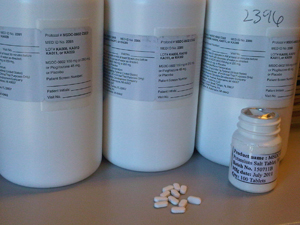
Drugs for type 2 diabetes can contribute to weight gain, bone fractures and cardiovascular problems, but in mice, an investigational drug appears to improve insulin sensitivity without those troublesome side effects, researchers at Washington University School of Medicine in St. Louis have shown.
The experimental medicine works through a different pathway, which could provide additional molecular targets for treating insulin resistance and diabetes. The new study appears online in the Journal of Biological Chemistry.
“Current diabetes medications activate a receptor that improves insulin sensitivity, but unfortunately also contributes to side effects that make some people discontinue the medication, contributing to other health problems,” says principal investigator Brian N. Finck, PhD. “So even though these drugs are effective, we’d really like to find new insulin-sensitizing therapies that would avoid activating the same receptor.”
Finck, a research assistant professor of medicine in the Division of Geriatrics and Nutritional Science, worked with colleagues at the University of Michigan and at the drug discovery company Metabolic Solutions Development Co., LLC. The scientists studied one of the company’s investigational drugs, MSD-0602, focusing on its effects in obese mice.
The drug improved blood glucose levels and insulin tolerance in the mice, as did the two diabetes drugs that already are on the market: rosiglitazone (Avandia) and pioglitazone (Actos). All three medications appeared to be about equally effective, but MSD-0602 didn’t bind to and activate a receptor in cells called PPARγ. Rather, the investigational drug clings to the mitochondria, part of the cell that produces energy.
“The drug altered the cell’s ability to generate energy,” Finck says. “And it also seems to have an anti-inflammatory role in the cell. We also found that the drug improved insulin sensitivity in many different kinds of cells including muscle, fat and liver cells.”
Next, he and his colleagues will attempt to identify proteins that bind to the mitochondrial membrane. Future therapies then could be developed specifically to bind to those proteins while avoiding activation of the PPARγ pathway.
“During the last few years there has been some hesitation in the drug-development business about targeting PPARγ based on what we’ve learned about side effects from drugs that regulate that pathway,” Finck says. “So the biologist in me is very interested in identifying other targets for diabetes drugs and understanding their role in regulating metabolism.”
Meanwhile, Metabolic Solutions is testing the investigational drug in patients as part of phase II clinical trials to learn how well it controls their blood glucose.
Chen Z, Vigueira PA, Chambers KT, Hall AM, Mitra MS, Qi N, McDonald WG, Colca JR, Kletzien RF, Finck BN. Insulin resistance and metabolic derangements in obese mice are ameliorated by a novel peroxisome proliferator-activated receptor γ-sparing thiazolidinedione. Journal of Biological Chemistry, published online May 2012; http://www.jbc.org/content/early/2012/05/23/jbc.M112.363960.
McDonald, Colca and Kletzein are employed by Metabolic Solutions Development Co., LLC.
Funding comes from the National Institute of Diabetes and Digestive and Kidney Diseases, and the National Institute on Alcohol Abuse and Alcoholism of the National Institutes of Health (NIH), with additional grants from the Barnes-Jewish Hospital Foundation and the American Liver Foundation. NIH grant numbers R41 DK084596, R42 AA021228, P30 DK52574, P30 DK56341, and T32 DK007296.
Washington University School of Medicine’s 2,100 employed and volunteer faculty physicians also are the medical staff of Barnes-Jewish and St. Louis Children’s hospitals. The School of Medicine is one of the leading medical research, teaching and patient care institutions in the nation, currently ranked sixth in the nation by U.S. News & World Report. Through its affiliations with Barnes-Jewish and St. Louis Children’s hospitals, the School of Medicine is linked to BJC HealthCare.